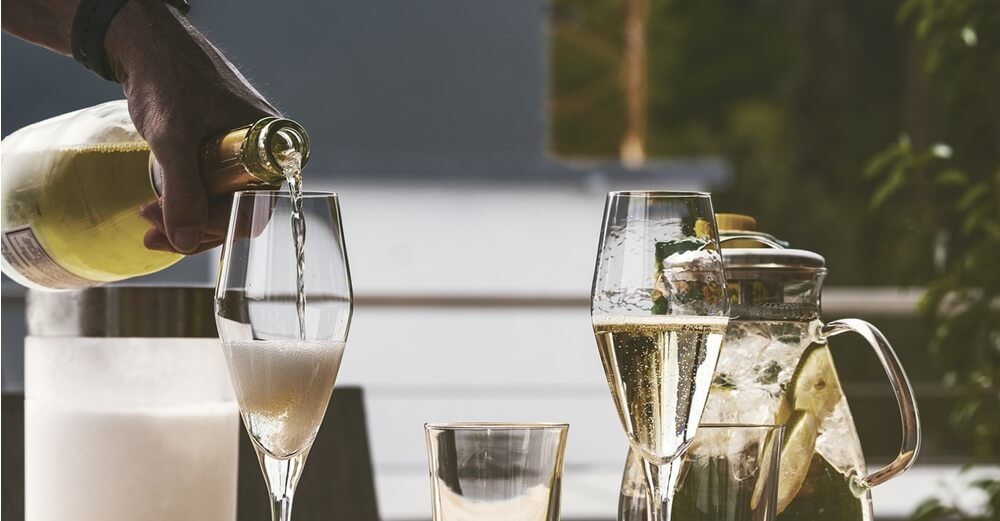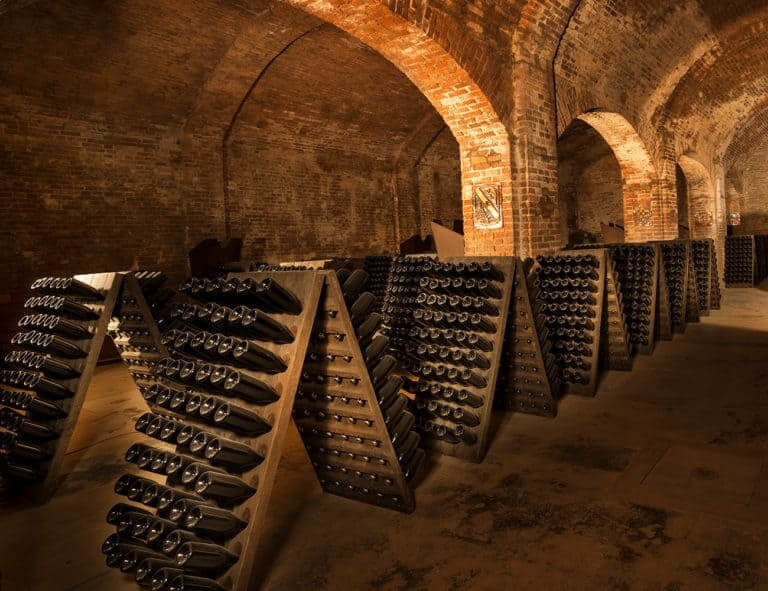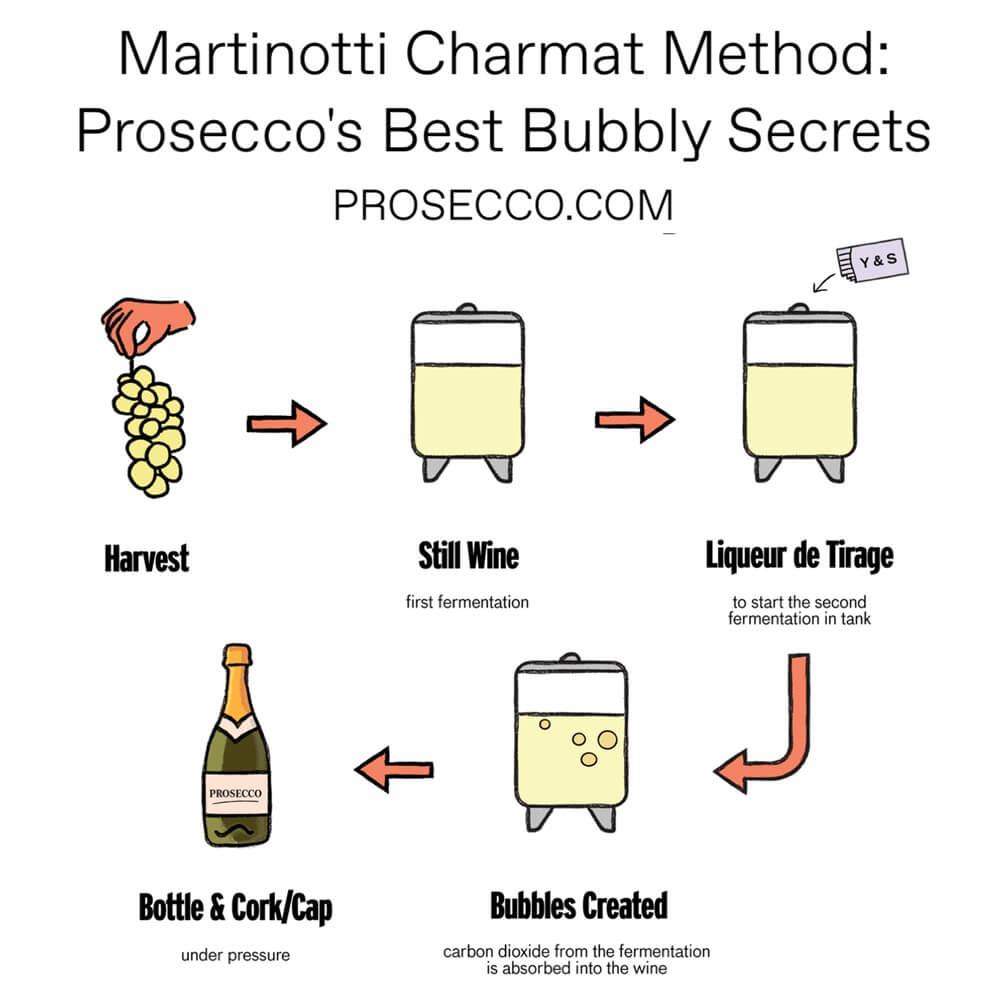Champenoise Method vs. Charmat Method
An In-Depth Analysis of Sparkling Wine Making Methods

In previous article about Northern Italian sparkling wines, there has been much talk about the main Classic methods of this macro-region of Italy, but what is the difference between the classic method and the Charmat method?
Are the Classic method and the Champenoise method the same thing? Charmat and Martinotti, who are they and what have they done?
Let’s look at it together and shed some light by trying to answer these questions.
The production of sparkling wine is a process that has fascinated winemakers and wine enthusiasts for centuries. The magic of the bubbles that form in a bottle of sparkling wine is not only the result of a physical process, but also the fruit of different winemaking techniques that profoundly influence the profile of the wine.
In Italy, as in the rest of the world, there are two main methods for producing sparkling wines: the Classic Method also known as the Champenoise Method and the Martinotti Method also known as the Charmat Method.
While both methods can produce exceptional products, they are distinguished by their technique, production time and the flavour profile of the resulting wines.

The Classic Method: An Art That Has Been Handed Down for Centuries
The Champenoise Method is one of the oldest and most prestigious methods for producing sparkling wine.
This process is famous for being the basis of one of the most iconic wines in the world: Champagne, however, as described in the previous article, the Classic Method is also used to produce other famous and iconic sparkling wines, such as Franciacorta in Lombardy, Trento DOC and other sparkling wines in Italy, France and around the world.
The Champenoise Method has a history that dates back to the 17th century, but was perfected in the 18th and 19th centuries. Its origin is linked to the Champagne region, in north-eastern France, where the climatic and geographical conditions favored the production of high-quality wines, but not sparkling wines at the beginning.
Around 1670, the winemakers of Champagne noticed that some bottles of wine, stored in the cellar, had developed bubbles.
This was partly due to the fermentation that resumed inside the bottles after the winter, as temperatures rose. However, these “accidents” led to the discovery that the wine in the bottle could develop effervescence, but the result was often an unstable and not always pleasant wine.
In the 18th century, the winemakers of Champagne, particularly those of Hautvillers, where the Benedictine monk Pierre Pérignon worked, began to refine the process.
Dom Pérignon is often credited with helping to improve the quality of sparkling wine, introducing practices such as selecting quality grapes, using sturdier bottles (that could withstand the internal pressure), and perfecting the technique of blending different grapes to obtain a more balanced product.
The real innovation of the method, however, was the improvement of the second fermentation in the bottle, which occurs thanks to the addition of sugars and yeasts to the basic wine, followed by the alcoholic fermentation.
During the 19th century, Champagne production became increasingly popular, with the Méthode Champenoise recognized as the key to the quality of the wine. This method has remained in use to this day, and has become the model for sparkling wine production around the world, with similar techniques being adopted in other wine regions.

How the Classic Method Works:
The process begins as any still wine, with the alcoholic fermentation of the grape must, which becomes the base wine.
After this phase, the wine is bottled together with a mixture of sugar and yeast (liqueur de tirage), and the bottle is closed with a temporary crown cap. At this point, the second fermentation begins directly in the bottle.
This phase is essential because the fermentation of the yeasts produces carbon dioxide, which remains trapped in the bottle, thus creating pressure and bubbles.
One of the distinctive characteristics of the Classic Method is the maturation on the yeasts, which can last from 9 months to several years,up to decades depending on the quality and type of sparkling wine you want to obtain.
During this long period of refinement, the wine develops a unique complexity, acquiring hints of bread crust, hazelnut, toast and other complex aromas resulting from the interaction between the wine and the yeasts.
Once the wine has reached the desired maturation period on the yeasts, the remuage is carried out.
Remuage consists in arranging the bottles on inclined supports called Pupitres, which are then subjected to a progressive rotation, simultaneously increasing their inclination, until they are vertical on their tip.
The chef de cave (cellar master) grasps the bottom of the bottles with the palm of his hand, imparting the rotation with an almost ancestral gesture, to bring the sediment into the neck of the bottle.
Then, the wine is disgorged (Dégorgement), an operation that involves the elimination of the sediments. Nowadays, we find two types of disgorgement:“à la volée” is the historical type of disgorgement that is rarely used today.
This is a relatively laborious process, which requires a lot of skill and experience. Holding the bottle facing downwards, the crown cap is removed with a special tool. Care must be taken not to lose too much sparkling wine or carbon dioxide when the yeast sediment is expelled.
Cold disgorgement, the most used method today, was invented by the Frenchman Armand Walfard-Binet, of the Binet house in Reims (a city of Champagne), and patented in 1884. The bottles are placed upside down with the neck in an icy saline solution (-15-35 ºC).
The presence of alcohol ensures that the sediment in the neck of the bottle does not freeze, but takes on a grainy consistency. The bottle cap is equipped with a small plastic cylinder (bidule), which ensures the closure is airtight, while also serving as a collector for the lees.
When the crown cap is removed, the compacted lees are expelled. The low temperature ensures that the carbon dioxide remains almost completely dissolved in the wine, without pressure losses
To fill the void in the bottle after disgorging, the liqueur d’expedition, a wine-based mixture, is added.
The composition always varies and it is secret for each winery. Usually the first bottles are sacrificed to fill the following ones, but there is nothing to stop you from adding spirits or a different wine. The liqueur d’expedition helps to give the wine of each winery its own unique character.
Characteristics of the Classic Method
The Champenoise Method produces sparkling wines that require longer aging and therefore develop greater complexity than other methods. The bubbles that form are thin and persistent, which give the wine a creamy and velvety texture.
In addition, the prolonged interaction with the yeasts gives the wines more complex aromas and a more robust structure.
These wines are perfect for pairing with elaborate dishes, such as shellfish, aged cheeses, fried foods and can also be enjoyed alone as an aperitif or on special occasions. Among the most famous examples of sparkling wines produced with the Classic Method are Champagne, Franciacorta and Spanish Cava.

The Martinotti Method (Charmat): Modernity and Freshness
The Martinotti Method, also known as the Charmat Method, takes its name from the Italian winemaker Luigi Martinotti who, in 1895, patented a fermentation system in an autoclave, a large pressure tank.
The method was then improved and patented by the Frenchman Eugéne Charmat about fifteen years later, and is now universally known as the “Charmat Method”. This method is more recent than the Classic Method and is mainly used for the production of fresh and fruity sparkling wines, such as Prosecco.
How the Martinotti Method Works:
The Martinotti Method differs from the Classic Method mainly for the fermentation. In this case, the second fermentation does not take place in the bottle, but in a large sealed and pressurized container where the base wine is mixed with sugar and yeasts.
Inside the autoclave, the fermentation takes place in a relatively short time, from a few weeks to a few months, producing the carbon dioxide that creates the bubbles.
Once the fermentation is completed, the wine is filtered to eliminate the residual yeasts and then bottled, ready to be consumed. A long maturation is not necessary as in the Classic Method, which makes the Martinotti Method much faster and less expensive.
Characteristics of the Martinotti Method:
Wines produced with the Martinotti Method are generally fresher and lighter. The bubbles that form are larger and less persistent than those of the Classic Method.
The absence of a long maturation on the yeasts means that these sparkling wines retain fresher aromas, with strong notes of fruit and flowers. You can perceive a greater liveliness and less complexity than wines produced with the Classic Method.
This makes the Martinotti Method ideal for the production of sparkling wines suitable for drinking young and fresh, such as Prosecco or Moscato and other light and fruity sparkling wines. These wines are perfect for an aperitif or as an accompaniment to light dishes such as appetizers, salads, fish dishes or Asian cuisine or for paring with dessert.
And what is the Ancestral Method?
The ancestral method is a traditional technique originating in the area of Blanquette de Limoux sparkling wine in France, then used for the production of sparkling wines also in Champagne.
It is one of the oldest methods of sparkling wine production and differs from the more well-known Classic Method in some aspects.
After the first fermentation, the base wine follows the same procedure as the Chamepenoise Method, but unlike this, where the sediments are removed from the bottle through the degorgement process, in the Ancestral Method the yeasts are not eliminated.
Therefore, the wine may appear cloudy, with a slight presence of yeasts that increases its organoleptic characteristics.
The final result is a sparkling wine that has a more rustic profile, with marked notes of yeast, and therefore of bread crust.
Conclusion: Which Method to Choose?
The choice between the Classic Method and the Martinotti Method depends mainly on personal preferences and the occasion in which you intend to consume the wine. If you are searching a complex, structured wine, with a great capacity for aging and greater elegance, the Classic Method is the ideal choice.
Perfect for special occasions, such as celebrations or pairings with more complex and elaborate dishes, the Champenoise Method is synonymous of quality and tradition.
If, on the other hand, you are searching a fresh, young, lively and fruity wine, the Charmat Method is the one for you. Ideal for an informal aperitif, for a party with friends or for light dishes, the Martinotti Method offers a pleasant freshness and lightness that makes it easily appreciated.
Ultimately, both methods offer quality sparkling wines, but each of them tells a different story, made of tradition, innovation and passion.
The choice is yours!
